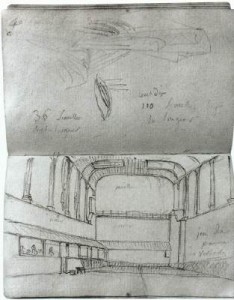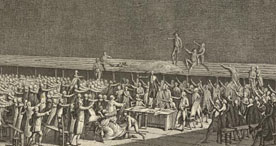[Copyright: Musée de la Ville, Paris on loan to the Musée National du Château, Versailles]
Artist: Jacques-Louis David (1748-1825)
Title: The Tennis Court Oath (Le Serment du Jeu de Paume) establishing the National Assembly took place on the jeu de paume Versailles on the 20 June 1789.
Date: 1790 – May 1791
Media: Oil on Canvas
Collection: Musée de la Ville, Paris
David completed the final study for the Tennis Court Oath in May 1791 and the work was shown in the Salon of 1791. David intended to do a further painting based on this composition but it was never completed. In preparation for this work, David produced a number of sketches and preparatory works notably the Versailles and Louvre Sketchbooks and individual drawings.
David’s Versailles Sketchbook (held in the Musée National du Château, Versailles) contains a number of preparatory drawings for the finished study including a sketch he made on the court at Versailles:
[Copyright: Musée National du Château, Versailles]
Title: View of the interior of the tennis court (fol. 33)
Date: 1790-91
Media: Black chalk
Dimensions: 125 x 192 mm (each page)
Collection: Musée National du Château, Versailles
Warren Roberts notes that the difference between the look of the court in this sketch made on site and the design of the court in the finished work was deliberately changed by David to enhance the dramatic effect of the scene: “When that sketch (fol. 33, Versailles Sketchbook) is compared with the final study of 1791 it is evident that David used artistic license in lowering the walls and ceiling to give greater prominence to the figures swearing the oath. This is but one of several liberties he took in designing the Tennis Court Oath.” p. 52
[Source: Warren Roberts, Jacques-Louis David, Revolutionary Artist: Art, Politics and the French Revolution (University of North Carolina Press, 1989)]
There are a number of other works inspired by David’s work and composition.
[Copyright: British Library Board Shelfmark 1850.c.28]
This print (1804) is one of five plates on Scenes of the French Revolution.
The following entry is taken from the British Library website.
“This illustration depicts the Tennis Court Oath (Le Serment du Jeu de Paume) of Versailles, 20 June 1789. The National Assembly, also known as the Third Estate, was an ancient but little used gathering of nobles, clergy and common people. They were excluded from their regular meeting place by King Louis XVI and met instead at a nearby indoor tennis court. Here they pledged themselves to create a written constitution for France.
Mirabeau, the leader of the Assembly, turned to the King’s messenger and cried:
Go tell your master that we are here by the will of the people, and that we shall be removed only at the point of a bayonet.
Revolutionary governments were set up, first in Paris and then in the provinces. On 4 August a decree was passed to abolish the whole feudal system.
The constitution was completed in 1791. France was given a limited monarchy and a representative one house legislature (a law-making body able to debate and vote upon laws). The constitution included a declaration of the rights of man:
- All citizens are born free with equal rights
- All have a right to participate in electing representatives to make laws
- All are entitled to free speech (provided the privilege is not abused)
- Taxation will be related to wealth
The monarchy was short lived. There were deep divisions between those who wanted to keep a limited monarchy and those who wanted to be rid of the King. Louis failed to abide by the constitution and the mob invaded his palace in August 1792. He was convicted of conspiring with foreign countries to invade France, and beheaded on the guillotine.


